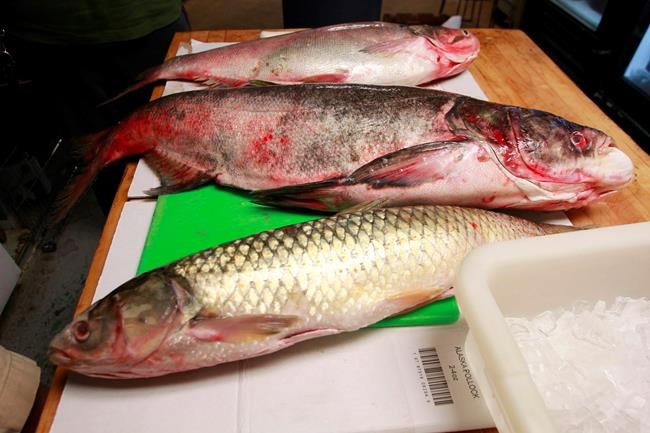
Study says grass carp have invaded 3 of the Great Lakes
TRAVERSE CITY, Mich. – Invasive grass carp have reached three of the Great Lakes and pose a significant environmental risk there, but time remains to prevent them from getting out of hand, according to a scientific analysis released Friday.
The voracious grass carp is among four Asian carp species threatening to reach the world’s largest surface freshwater system. Bighead and silver carp, the most feared, would compete with native fish that eat microscopic plants and animals, while grass carp feast on aquatic vegetation that provides crucial habitat and spawning grounds.
Grass carp have been found in Lakes Erie, Michigan and Ontario, although it’s uncertain how many there are or how widely they have spread, U.S. and Canadian researchers said. At least some are reproducing.
“For the first time, we have a binational, peer-reviewed study by some of the best minds and practitioners in the field who have a consensus on what the risk is to the Great Lakes from grass carp, and it’s pretty substantial,” said Marc Gaden, spokesman for the Great Lakes Fishery Commission.
Grass carp were introduced to the U.S. in the early 1960s to control weed growth in waterways. Like other Asian carp, some escaped into the Mississippi River and have migrated northward toward the Great Lakes.
It has long been known that at least a small number of grass carp were in the lakes, Gaden said. Some may have slipped into Lake Michigan through a Chicago-area waterway network before electric barriers were erected to block fish migration. People might have released others, intentionally or by accident.
“They’ve just been humming in the background,” Gaden said. “They haven’t gotten a lot of attention. Once in a while one would get captured.”
But they have turned up more often in recent years and the threat of a full-fledged invasion appears to be rising, he said. A particularly ominous sign is that some of those caught have been fertile. Grass carp reared in hatcheries, which some states allow, are supposed to be sterilized before being released into the wild.
Twenty-three grass carp have been caught in Canada since 2012, including five in Lake Ontario at Toronto, said Becky Cudmore, Asian carp program manager for Canada’s fisheries and oceans agency and the report’s primary author.
“Right now, the sterile fish outnumber the fertile fish,” Cudmore said. “This isn’t game over, but we are finding more of these fertile fish.”
The analysis said it is “very likely” that grass carp will become established in Lakes Erie, Huron, Michigan and Ontario within 10 years unless effective steps are taken to stop them. The risk is lower in frigid Lake Superior, which offers less food.
An established population is one that reproduces over multiple generations.
Researchers are studying how to prevent that, Gaden said. Tougher enforcement of laws against bringing them into the region would help, along with greater care to prevent release of fertile fish from hatcheries.
Another possibility would be using nets to block their path to spawning areas during times when they reproduce, Cudmore said. Asian carp are known to spawn later than native fish.
“Our assessment is saying that yes, they were showing up before, but now they’re starting the invasion process,” she said. “They have arrived. Now is the time to act.”
Join the Conversation!
Want to share your thoughts, add context, or connect with others in your community?
You must be logged in to post a comment.
















